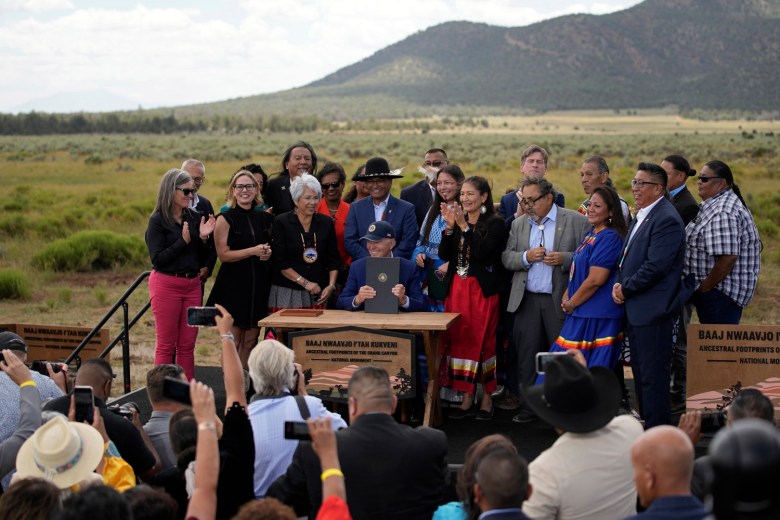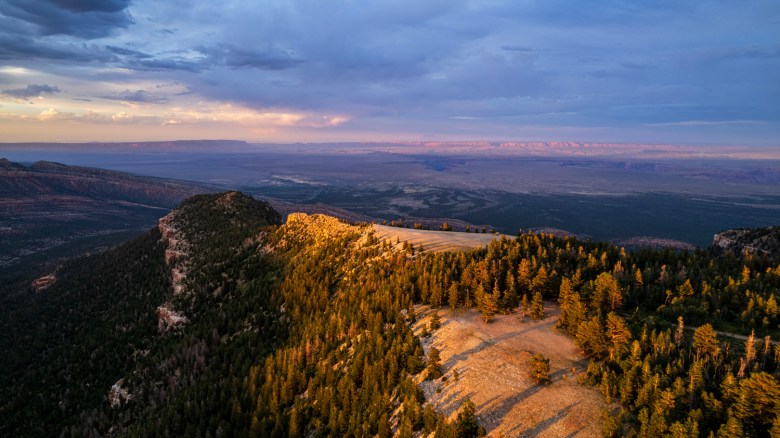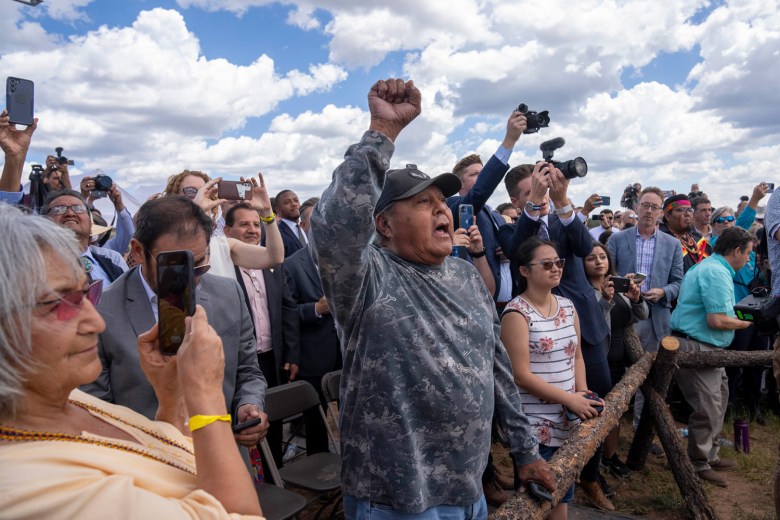
The designation of the Baaj Nwaavjo I’tah Kukveni-Ancestral Footprints of the Grand Canyon National Monument earlier this week protects nearly 1 million acres of culturally significant and ecologically diverse landscapes, from grasslands to ponderosa forests, adjacent to Grand Canyon National Park. Baaj Nwavjo means “where tribes roam” in Havasupai, and I’tah Kukveni means “our ancestral footprints” in Hopi.
President Joe Biden signed the proclamation in front of the sagebrush and piñon forest of Red Butte, a sacred mountain known as Wii’i Gdwiisa by the Havasupai and Tsé zhin Ii’ahi by the Diné. “Standing here at Red Butte represents the unity of the tribes to protect our ancestral lands,” said Maya Tilousi-Lyttle, a teenager from the Hopi and Havasupai tribes who introduced Biden. Tilousi-Lyttle is the daughter of Carletta Tilousi, former Havasupai Tribal Council member and coordinator of the Grand Canyon Tribal Coalition, which consists of the 13 tribes that brought the monument proposal forward.
The monument designation was the culmination of decades of Indigenous efforts across the political system, including protests against uranium mining, get-out-the-vote efforts in Arizona, and, in recent years, work with the Biden administration. When Grand Canyon National Park was established over a century ago, the federal government forcibly removed Native people. The proclamation acknowledges this violent history and outlines steps for co-stewardship and co-management of the monument with tribes, including the creation of a commission with representation from each tribal nation with ancestral ties to the area. This is the third monument initially proposed by Indigenous-led coalitions; the others are Bears Ears and Avi Kwa Ame.
The monument also protects thousands of cultural sites, endangered and endemic plants and wildlife, and seeps and springs that flow into the Colorado River — the water source for 40 million people.
“I grew up into this movement. My family were the ones that really spoke out about protecting our sacred places.”
The Grand Canyon Tribal Coalition consists of the Havasupai Tribe, Hopi Tribe, Hualapai Tribe, Kaibab Band of Paiute Indians, Las Vegas Tribe of Paiutes, Moapa Band of Paiute Indians, Paiute Indian Tribe of Utah, Shivwits Band of Paiutes, Navajo Nation, San Juan Southern Paiute Tribe, Yavapai-Apache Nation, Zuni Tribe and Colorado River Indian Tribes. The tribes united as a coalition in September 2022, but for centuries, they have been connected through a system of trails and the Colorado River. They launched their monument campaign in April, building on Indigenous resistance to uranium mining and legislative and monument proposals brought forth by Rep. Raúl Grijalva, D, since 2008. Tilousi was a teenager when the mining company Energy Fuels first approached the Havasupai Tribe about mining near Red Butte in 1984. “I grew up into this movement,” said Tilousi. “My family were the ones that really spoke out about protecting our sacred places.”

In the past few years, the political landscape shifted. “What is different now is that the administration is willing to meet with us,” Tilousi said.
Interior Secretary Deb Haaland (Laguna Pueblo) has made protecting sacred cultural sites a priority. “This land is sacred to the many tribal nations who have long advocated for its protection, and establishing a national monument demonstrates the importance of recognizing the original stewards of our public lands,” Haaland said. Biden said the monument designation will honor his promise of respecting tribal sovereignty and his commitment to conserve 30% of America’s lands and waters by 2030. The monument meets the America the Beautiful For All Coalition’s calls for at least 40% of those 30×30 conservation investments to be in communities of color.
Support for the monument has grown as Arizona turned blue. A June 2023 poll showed that 75% of Arizona voters support it. Along with Grijalva, Arizona officials supporting the monument include Sens. Kyrsten Sinema, I, and Mark Kelly, D; Rep. Ruben Gallego, D; Gov. Katie Hobbs, D; 37 state legislators, and more. The Native vote influenced this political shift: In the 2020 presidential election, Arizona precincts that voted for Biden overlapped nearly completely with tribal nations.
Tara Benally, a Diné and Hopi organizer who worked to get out the Native vote in 2020 with the Rural Utah Project and Rural Arizona Project, said that getting Native communities to the polls empowers them to engage in the political process, from voting to organizing campaigns to protect ancestral lands. “I know we (Indigenous people) need to continue to register to vote,” Benally said. “Because if we don’t participate in this process, we will be put back 10, 20, 30 years.”
The monument also got broad tribal support by addressing the issue of uranium mining. A 20-year halt on new mining claims issued in 2012 will become permanent. However, mining claims that predate 2012 will remain, and two approved mining operations within the boundaries of the monument will be able to operate.

Navajo Nation President Buu Nygren told High Country News that being part of the coalition is a no-brainer because the monument will prevent future uranium claims in the area and make it harder for the uranium industry to operate. “I think it’s putting pressure on them to close up the shop and get out.” There are over 500 abandoned uranium mines across Navajo Nation, which has had a uranium ban since 2005.
“I think it’s putting pressure on them to close up the shop and get out.”
Pinyon Plain Mine, owned by Energy Fuels and exempt from the ban on mining, sits just three miles north of the Red Butte Airfield where Biden signed the monument. Tribes worry that mining will contaminate groundwater that flows into springs and seeps and the Colorado River. Tilousi said any contamination of Havasu Creek and the famous Havasu Falls would decimate the Supai people who depend on that water source. “It’s practically a life-and-death struggle here, so that’s why the Supai is not willing to take the risk,” she said.
In an email, Energy Fuels said, “There is no scientific evidence that mining the deposits in the national monument area have had any adverse health or environmental impacts over the past 50 years.” But Amber Reimondo, energy director for Grand Canyon Trust, argues that the lack of evidence is owing to a lack of research, due to the high cost of studying the issue in the vast, remote and complex environment.
Even though the monument didn’t stop Pinyon Plain Mine, Indigenous leaders hope public pressure will eventually force the mine to shut down.
Tilousi-Lyttle said she will continue following her mother’s journey to protect her ancestral homelands. “I’m here representing the next generation that has a responsibility to continue this vital work. This is our home, and we are committed to its protection.”
Brooke Larsen is the Virginia Spencer Davis Fellow for HCN, covering rural communities, agriculture and conservation. She reports from Salt Lake City, Utah. Email her at brooke.larsen@hcn.org or submit a letter to the editor. See our letters to the editor policy. Follow her on Instagram @jbrookelarsen or Twitter @JBrookeLarsen.
Alastair Lee Bitsóí is Diné from Naschitti, Navajo Nation, New Mexico. An award-winning journalist, he formerly reported for The Navajo Times and The Salt Lake Tribune and now works as a correspondent for High Country News and other outlets.

